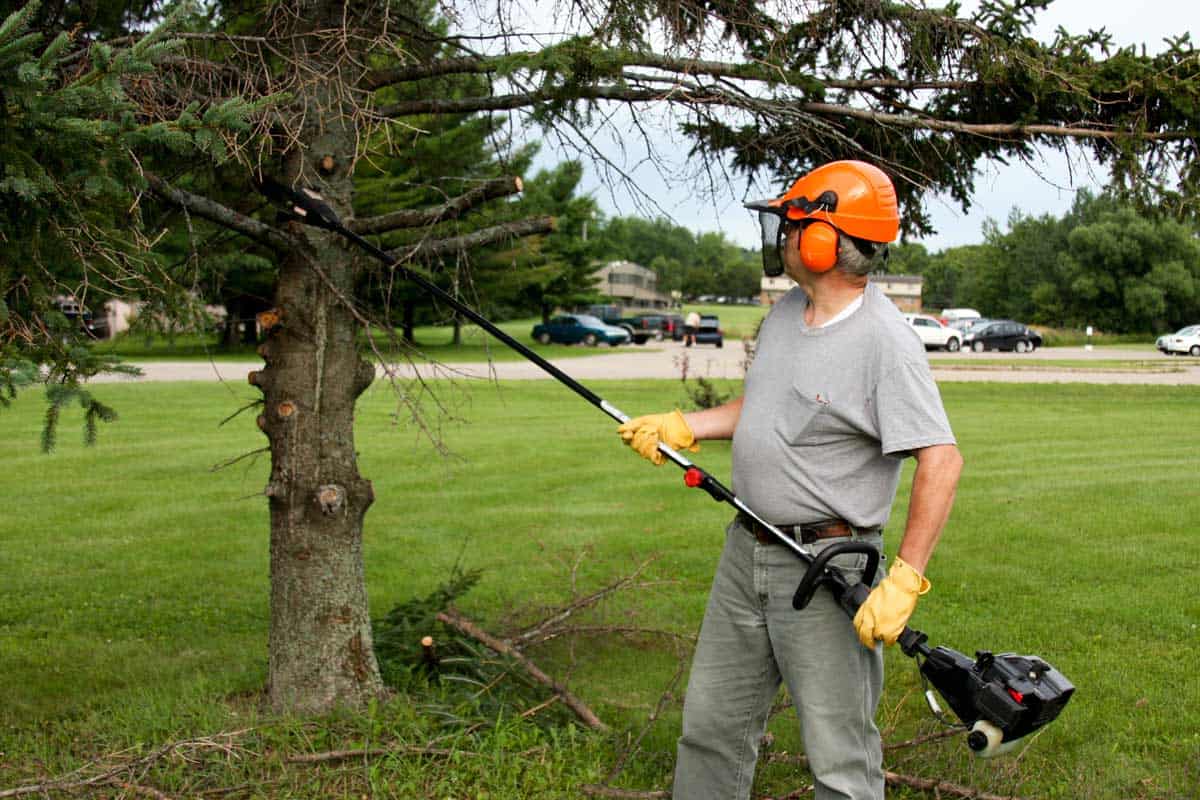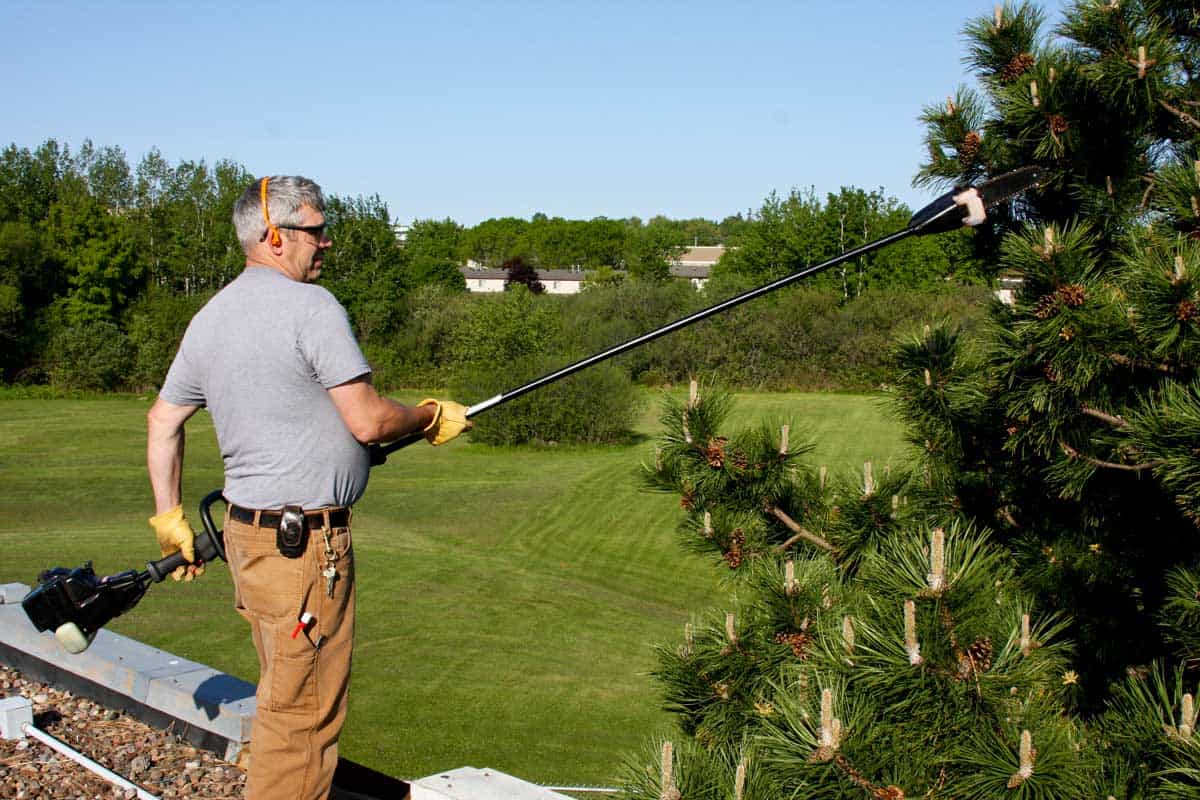 Pine trees are a very common tree to be included in neighbourhoods, landscapes, and other inhabited areas due to their low maintenance nature and ability to grow in many different kinds of soil. However, sometimes branches die, and you need to do some trimming. We've done the research, so you can learn how to take the best care of your tree!
Pine trees are a very common tree to be included in neighbourhoods, landscapes, and other inhabited areas due to their low maintenance nature and ability to grow in many different kinds of soil. However, sometimes branches die, and you need to do some trimming. We've done the research, so you can learn how to take the best care of your tree!
Pine trees should be trimmed in spring or summer when they will be growing and will have the energy to repair the wounds you've made. If trimming off entire branches, take the branch off at the thickest part, near the trunk. The best way to trim for reduced height and width is to trim anywhere from a third to half the new growth off in spring or summer.
Do you still have questions? There are many different variables you may still be concerned about, so keep reading to have your questions answered!
How To Correctly Trim A Pine Tree
You need to be careful when pruning pine trees, specifically because of the weight. Between needle clusters, pine cones, the weight of the branch itself, and the varying density of the wood between species of pines, pine branches can be quite heavy. Because of this, if you are not careful when removing a branch, you can end up tearing away the exterior bark, which exposes the tree to insect attacks and disease.
Additionally, there are different ways of trimming your pine tree depending on the area you want to trim, and the result you want in the long run.
If you want your tree to have thicker foliage, you can accomplish that through careful trimming to remove dead, diseased or otherwise unseemly branches. In the spring, pinch or cut off half to two-thirds of as much of the tree's new external growth as you can get your hands on. These new growths on the ends of the tree branches are called candles, and that's precisely what they look like. This will help redirect all the new growth energy the tree has to the internal new growth, helping the tree become bushier and denser. Make sure to be careful of the needles when you do this, as partially clipped needles will turn brown, leaving small unsightly areas all over the outside of your tree.
Whole Branches
You may be wanting to trim off entire branches from the base of the tree to improve access around the trunk. Before you do this, remember that pine trees don't get new growth around the areas where you trim off branches, so once the limb is gone, you're not going to get any further growth in that area. You might try first trimming growth off the branch itself if you're not sure that you want entire branches gone.
However, if you know that's what you want, there is a safe way to do it that will help minimize the damage that is done to the tree. Start by disinfecting the tool you're using to do the cutting. This will help prevent any disease or sickness from infecting the tree.

Assuming that the branch in question is too think to cut the branch off using limb loppers, you're going to saw the branch off in segments. This will generally only take two sections, but you can do more if that makes you feel safer. Start by cutting a notch on the bottom of the branch below where you're going to be sawing from above. This notch should be at least a foot away from the trunk of the tree and will ensure that the branch will fall where you're cutting it, instead of breaking and swinging once you get close to the bottom of the branch.
Once you've finished that, you should end up with a section of the limb about a foot or so long. Trimming your tree this way prevents the tree limb from breaking off unevenly, and stripping wood and bark off the trunk of the tree, which makes it more vulnerable to bug infestations and disease. By clipping the branch down to a one-foot piece, changes of this happening with the final cut are dramatically decreased.
Finish up by making another notch at the bottom of the segment that's left, right in front of the area where the branch swells before it connects with the tree. This area is called the collar, and leaving it there will help the tree heal and recover more quickly. Continue cutting from the top until the remaining segment has been completely removed.
This method will be the same regardless of whether the branch is alive or dead. Dead branches should be removed promptly to prevent damage to you, your yard, and the tree itself.
Partial Branches
If a branch becomes diseased or infested with bugs, it should be removed before either of them spread to other branches or the trunk of the tree. If this happens, look for the area where you can identify the damage closest to the tree trunk, and then keep going another five to six inches before you mark the area to remove the branch. This ensures that any unseen strains of sickness don't get left in the branch to wreak havoc on your tree later.
What Season Is Best For Trimming?
Spring is the best time for you to trim any of your trees. With the new energy, they have for spring growth, any of the wounds that get made by your clipping and trimming with heal faster than they usually would, which in turn will help the tree stay safe from bug infestations and sickness.
That being said, tree damage should be taken care of as soon as you notice it, so if you have to do some trimming in the summer too, that's completely fine. It's best to have all trimming and cutting for your trees done before fall and winter, which is when the trees will be going dormant, and won't have as much energy to be devoted to repairing themselves.
How Do You Trim A Pine Tree That Is Too Tall?
Making A Tall Tree Shorter
There isn't an excellent way to make a pine tree shorter. There is an obvious answer, which is just to cut the top off. This practice is called topping, and when it comes to pine trees, this is not a good method by which to trim your tree. Topping opens up a mainline directly to the trunk of the tree for sun damage, water damage, bugs, and disease, which can damage and kill the tree. Not to mention you would be destroying the classic conical shape of the tree.
Long story short, there is no good way to make a tall pine tree shorter.
Trimming A Tree That is Tall
If there are areas of a tall tree that need to be trimmed but are out of your safe reach, there are almost always small local businesses that are trained to remove branches that are up too high, and they'll have the tools to do it. You don't have to worry about falling out of your tree, and you get to support a local business at the same time!
Never climb a tree carrying sharp tools. You could lose your balance while trying to cut, and you could fall out of the tree. You might also fall onto the tools. In this case, it's best to let professionals handle it. Find out just how tall pine trees can get by clicking here!
Can Trimming A Pine Tree Kill It?

Pine trees can be potentially killed by a trimming or cutting job. The cuts you make on the tree can become infected if the tools you use aren't clean, and each fresh wound on a tree is a temporary weak spot for sickness and bug infestations. You can also harm your tree by cutting off too much before the tree has time to recover, or my trimming it improperly.
For example, improper trimming of the branches can result in tears in the wood and bark of the trunk of the tree. Topping, or cutting off the top of the tree, leaves an open wound that will be more easily exposed to sun, rain, animals, and debris. As long as you're careful and give your tree time to recover, it should be fine.
Will Pine Tree Branches Grow Back?
No, they will not. If a branch from a pine tree has been removed, it's not going to grow back bushier like it caon many of its leafy counterparts. Once a branch has been cut off of a pine tree, it's gone for good, which is why you need to be thoughtful about your pruning habits.
Should You Cut The Bottom Branches Off Of A Pine Tree?
If you don't need to cut the branches off for accessibility, then you should probably refrain from doing so. They're not going to grow back, and on top of that, there's a reason that pine trees grow in the conical shape that they do. Pine trees commonly grow in areas that receive lots of snow, and there's a reason for that.

The conical shape of pine trees helps them bear lots of weight without breaking too many of their branches. This is important for areas that get lots of snow, as the snow puts a lot of pressure on the tree. When you remove the long, thick branches from the bottom of the tree, you're essentially removing the foundation, and effectively reducing the amount of weight that your tree can take.
However, if you've already removed the branches and don't like the gap that has been left, click here for some ideas of different plants you can grow underneath your pine to take up some space.
Why Do Some Pine Trees Lose Their Lower Branches?
Water stress is one of the primary reasons that lower branches would start to die. They will try to conserve energy to save the tree, so they begin to kill off their lower limbs. If you have noticed the lower branches on your tree start to die off, there's a good chance that your tree needs more water. There's also a chance it could have a fungal disease.
Pruning Pine Trees
